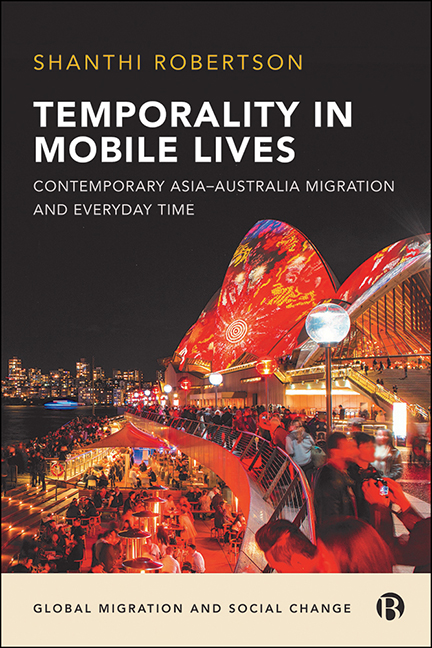Book contents
- Frontmatter
- Contents
- List of Figures
- Acknowledgements
- Series Preface
- Introduction
- 1 Chronomobilities: 21st-Century Migration and Lived Time
- 2 Asian Migrants of the Middle in Local and Global Context
- 3 Times of Work: Transified Workers and Contingent Careers
- 4 Times in Place: Moving, Dwelling, Belonging
- 5 Times of the Heart: Reconfiguring Intimacy
- Conclusion
- Notes
- References
- Index
Introduction
Published online by Cambridge University Press: 04 January 2022
- Frontmatter
- Contents
- List of Figures
- Acknowledgements
- Series Preface
- Introduction
- 1 Chronomobilities: 21st-Century Migration and Lived Time
- 2 Asian Migrants of the Middle in Local and Global Context
- 3 Times of Work: Transified Workers and Contingent Careers
- 4 Times in Place: Moving, Dwelling, Belonging
- 5 Times of the Heart: Reconfiguring Intimacy
- Conclusion
- Notes
- References
- Index
Summary
In 2004, as an undergraduate engineering student in South Korea, David came to Australia for six months on a one-year working holiday visa. His aim was to enjoy Australia and improve his English enough to be able to potentially apply for jobs internationally after he graduated. After a happy six months spent working odd jobs and completing an English course in sunny Brisbane, David returned to South Korea (hereafter, ‘Korea’), completed his engineering studies, and married Carolyn, a nurse. Wanting to share his Australian experience with his new wife, David brought Carolyn to Australia for their honeymoon, arriving in the tropical city of Cairns – a major tourist gateway ringed by ocean and rainforest, over 1,000 kilometres north of Brisbane. They were both struck by the vastly different daily tempo of Cairns compared with their lives in Seoul, where it was common for David to work 18-hour days at his engineering firm, and for Carolyn to do long shifts as a surgical nurse in a busy hospital. When I first met Carolyn, she recalled their honeymoon visit fondly:
‘I had a good impression of Australia because the thing is, the people in the park, the public park. I had seen the families, like parents and high school students with school uniforms. It was just half past three in the afternoon but in Korea that time there is no people, no family around. … In Cairns, it was a weekday and people were having picnics but in Korea there is not much time to spend with families at all so everyone has full time, even overtime is, well it's just almost every day for nurse. … There was no break or time off from the work.’
After their honeymoon, David and Carolyn began to read up on Australian migration policies, noting that nurses were an in-demand occupation for skilled migration. Although Carolyn would have to retrain to get an Australian nursing qualification, it seemed to the couple to be a clear pathway forward for them both to gain Australian permanent residency (PR). David would then be able to pursue graduate studies in Australia without having to pay the higher fees required of international students, and they could start a family in the relaxed and balanced pace of life they had witnessed on their honeymoon.
- Type
- Chapter
- Information
- Temporality in Mobile LivesContemporary Asia-Australia Migration and Everyday Time, pp. 1 - 14Publisher: Bristol University PressPrint publication year: 2021

